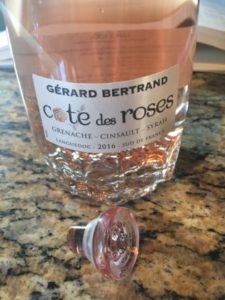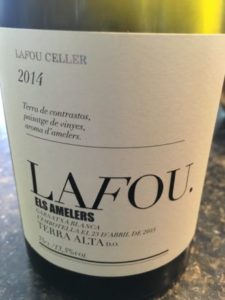Episode 114: Grenache Grape Gab With the Gals & a Little Mezcal
This week we’re all about the versatile Grenache grape and its various styles. You may hear some thunder in the background, but these gray days are the days made brighter by sharing wine with friends. Steph and Val get back to our podcasting roots, share lovely wines and a Mezcal factoid.
We’ve been on a roll with guests and great interview. Today’s episode takes us back to WHY we started podcasting in the first place. See, Val and I like to grape gab, spend time together, get our geek on and D.R.I.N.K. This week we are both drinking a style of grenacha also known as garnacha.
In Our Glasses:
 Val: 2015 Gerard Bertrand, Cote des Roses, Languedoc, France. This is a rose’ made with grenache, syrah and cinsaut. it’s probably one of less than a handful of times Val’s purchased a wine because of the bottle, but the quality producer’s name on the bottle sealed the deal.
Val: 2015 Gerard Bertrand, Cote des Roses, Languedoc, France. This is a rose’ made with grenache, syrah and cinsaut. it’s probably one of less than a handful of times Val’s purchased a wine because of the bottle, but the quality producer’s name on the bottle sealed the deal.
The wine is elegant with floral, jasmine, orange blossom happening in the glass, along with ripe raspberries and even some citrus, like blood orange. It’s bone dry.
Steph: 2014 LaFou Celler ELS AMELERS– Garnatxa Blanca – Terra Alta D.O. ($24). This is a Grenache Blanc that outshined many other wines at the Fort Collins WineFest this year. Adam at Supermarket Liquors had a few bottles left on his shelf, so Steph snagged a few.
LaFou is the name of the winery/bodega and is translated in Catalan to mean a narrow gorge where water passes. The name of the wine, Els Amelers, refers to the almond trees of the region that grow alongside the grape vines. The Terra Alta D.O. is in the NW of Spain in Catalonia.
It is 100% Grenache Blanc, fermented and aged 6 months in concrete egg vats & stainless steel tanks. Then 10% of the wine is aged in oak.
Main Discussion: Grenache Grape Gab continues …
Let’s dish out the down and dirty on Grenache one of the world’s most widely planted grapes. We should also point out that we’re going to lead with Grenache Noir, or Garnacha Tinta, not to be confused with the Garnacha Tintorera or Alicante Bouschet that we talked about a few weeks back. That’s a Garnacha cross, not a mutation.)
Where does it come from?
We all think of this as the black grape from the warmer growing areas of the world’s wine regions. As we mentioned earlier, it’s prolific in the South of France where it is often blended with Syrah and Morvedre and other grapes. Yet, it has only been known as Grenache since the late 1700s. Remember, the Languedoc-Roussillon, where Grenache was first believed to show its gnarly vine in France, is just up the coast from Spain. And this is where many people believe to be Grenache’s or Garnacha’s origin.
There are some, however, that believe the land of the Cannonau, Sardegna (Sardinia), off the coast of Italy, is the birthplace of Grenache/Garnacha. No one knows for sure.
The grapes
But what we do know is that it often falls into the top 10 of grapes grown around the world (about two years ago it was number seven according to University of Adelaide research, funded by the Grape and Wine Research Development Corporation and 2nd in all of France, according to Jancis in the Wine Grapes – speaking primarily of the Grenache noir.)
Grenache’s strong wood canopy, that is super helpful in windy growing conditions, unfortunately makes it difficult to harvest, especially with mechanical-harvesters. This is why you often see it grown low to the ground in what they call bush or gobelet-trained vines.
They grow well where it’s hot and dry, and are expected to remain a top world favorite as the climate change continues to be an issue.
The wines
Grenache (noir) wines are medium-high in alcohol, low in acidity, and express red and black berry flavors. Some clones have hick-skinned, small berries and if you think about wines from Priorat or Chateuneuf du Pape, they bring some weighty, full-bodied, deep, intense complexity to the party. These are normally found in the hotter regions. There are also clones that have thinner skins that make a more elegant, limpid style of wine. The great thing about Grenache is, truly, its versatility!
High sugar (from the long ripening) content also make it great for other wine styles, such as Vins du Naturels or fortified wines like the “best wine ever for chocolate, according to Val” Banyuls, Rivesaltes, Maury, and Baumes de Venise.
And speaking of wine styles, let us not forget rosé styles of Grenache, such as those more popular ones from Navarra, Spain and Tavel, France. Typically, we should note, that although they are pink, salmon or cherry in color, they are normally bone dry.
The mutation equation
Shall we talk mutations? Those are always fun!
Here’s why. Like we mentioned in the Shades of Gris Grape Gab about Pinot, this grape also likes to get it’s morph on. Therefore, there are other grapes and colors from which some of the world’s most enjoyed wines are made:
- Grenache Blanc (Garnacha Blanca), like what’s in Steph’s glass
- Grenache Gris (Garnacha Roja)
- Grenache d’Afrique, Grenache Poilu or Lledoner Pelut (Garnacha Peluda)
Where in the world?
So where can we find “old vine mutant ninja grenache” growing in the world outside of Spain, France and Sardegna?
Australia is also known for blends made with GSM (Grenache, Syrah, Mourvedre) blends, as well and the USA. We’re also seeing some fine examples in South Africa, Mendoza in Argentina and Maule Valley in Chile!
And just when you thought you couldn’t take one more factoid:
Factoid:
What is the difference between Tequila vs Mezcal?
Tequila is a sub-type of mezcal made specifically from the blue agave plant and can only five specific delimited areas in Mexico, including the state of Jalisco.
Mezcal can be made from an array of agaves from all over Mexico. Currently, mezcal is all the rage and new mezcalerias (mezcal bars) are opening all over the US. The sad part is that there isn’t enough mezcal to keep up with demand because the agave plants take 7-10 years to mature and harvest.
Check out a recent article in the NY Times addressing mezcal’s popularity and sustainability.
Winoradar:
The 2017 Colorado Wine Governor’s Cup Competition
Judging: July 8-9 (panel of sommeliers, chefs, writers, and wine experts from around the country)
Winner’s Tasting Event – open to the public: August 3rd in Denver
It is the only statewide wine making competition exclusively for Colorado wines and includes 250 wines from 35 local wineries. The link will give you more info including previous winners. So if you have any interest in tasting CO wines and learning about CO wine, the website is worth checking out.
Shoutouts:
Val: Shoutout to everyone who sat in on the Certification Summit Saturday morning on Austrian wines! The taste-along is certainly the way to go. Some of our listeners were in there as well, and we all learned a lot.
Also, thank you to Andrew for sending some May wine our way! We talked about it in Episode 111 during our Millennial Moment.
Steph: “I’ve got to reflect on my trip to NOLA not too long ago and give praise to Heather, our server at Peche who gave us outstanding service, really knew her stuff, and gave us the best experience. I also want to mention how excited I was to try the digestif called Underberg for the first time while at Peche. You want to know what’s in Underberg…???… well so do I. It is a family secret that dates back to 1846, and all we know is it is a composition of herbs from 43 different countries and it is DElicious! The stylish and traditional way to serve Underberg is in the tall glass that was designed for it (20mL teeny tiny bottle). Underberg tastes like Christmas, and I love it!”
Patreon Love:
Thank you so much to our Patreon supporters! Sending out some Patreon Love to:
“TENacious Tasters”:
Jeff E from the hilarious drinking show, We Like Drinking!
Lynn G from Savor the Harvest!
Sebastian S of Sassi Italy tours!
“It’s not five o’clock and we don’t care” listeners: Thank you:
- Meg from South Dakota!
- Clay from Arizona!
- Jon in California!
- Andrew in Illinois!
- Aswani in California!
We thank you for being a vital part of the W25 listening and sipping community.
Monthly Patreon Drawing:
Reminder – we have a new monthly Patreon drawing! Each month we are drawing a winner of a wine gift for all Patreon supporters at the $2/month Tastemaker Listener level and higher. Go to our Patreon page for details. www.patreon.com/winetwofivepodcast
Share the Love:
Here’s how:
Subscribe to our show and link it, tweet it or Facebook it. Grab someone’s phone and help them subscribe & push play!
OR
Leave us a burning wine question or comment on speakpipe.
OR
How about a glowing review on Apple Podcasts or iHeartRadio?!
ALSO,
But wait, there’s more! Check out our store where you can score wine books & accessories (for sure). It’s all on our website, along with links to Facebook, Twitter, Pinterest, YouTube, & Google+
Connect with Val on Twitter @WineGalUnboxed and as Vino With Val on Facebook, Instagram & Pinterest.
Steph is on Twitter, Instagram and Pinterest as the Wine Heroine. You can also connect with her personally on FaceBook.


